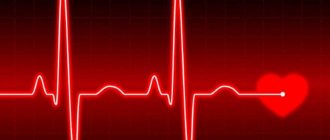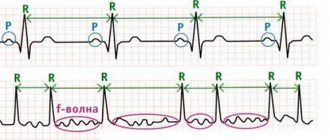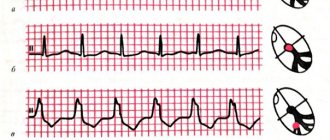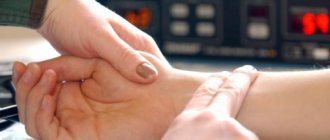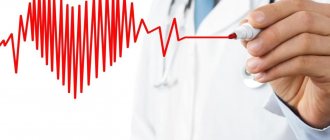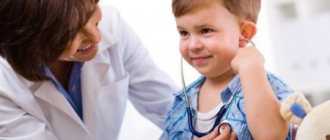Causes
Supraventricular extrasystole very often occurs without any particular reason. This form of extrasystole is diagnosed regardless of age and in absolutely healthy people and even in children.
The characteristic of this type of disease is that the impulses that arise in the atrium cause auxiliary contractions of the heart.
There are several reasons that provoke supraventricular extrasystole:
Heart diseases:
- Heart failure;
- Ischemic disease;
- Myocardial infarction;
- Congenital organ defect;
- Acquired organ defect;
- Inflammation of the myocardium - myocarditis;
- Cardiac myopathy.
Myocardial infarction
Endocrine system disorders:
- Diabetes mellitus - hyperglycemia;
- Pancreatic hyperthyroidism;
- Thyrotoxicosis;
- Adrenal gland disease.
Diabetes mellitus leads to disorders of the endocrine organs and can provoke the disease - supraventricular extrasystole.
The factor that provokes supraventricular extrasystoles is poisoning of the body with toxins:
- Alcoholism;
- Smoking;
Long-term use of cardiac drugs belonging to these categories also leads to supraventricular extrasystole:
- Drugs that reduce heart rate;
- Glycosides;
- Drugs with diuretic properties.
Disturbances in the functioning of the autonomic system cause heart pathologies.
Oxygen starvation of organs and the brain causes the following disorders in the body:
- Inflammation in the bronchi;
- Lack of iron in the blood - anemia;
- Apnea – cessation of breathing (nighttime).
Anemia
Why are supraventricular extrasystoles dangerous and what are their consequences?
Extraordinary supraventricular extrasystoles themselves do not pose a threat to human life and often go unnoticed. However, they can provoke the appearance of more severe rhythm disturbances: supraventricular tachycardia, atrial fibrillation and flutter, which lead to a sharp decrease in blood pressure, deterioration of blood supply to the myocardium and an increased risk of blood clots in the heart. A combination is often observed .
Long-term polytopic and blocked ES are considered the most unfavorable.
The consequences of supraventricular extrasystole are determined by the presence of: coronary heart disease, chronic heart failure, etc. The rhythm disturbance itself almost does not cause any complications.
Division of extrasystole by variety
The division is based on the root of the manifestation of the outbreak. Varieties of extrasystole can be:
- Location of the outbreak;
- Number of cuts;
- Organization of extrasystole;
- Number of additional cuts;
- Severity of symptoms;
- Manifestation over time.
Classification by location of extrasystoles
The locality of this variety is divided into:
- Sinus contraction - the root of localization is located in the sinus node of the atrium;
- Atrial contraction - pathology is located in the muscles of the atrium;
- Atrioventricular extrasystole - the source of the disease is in the wall that separates the ventricle from the atrium.
Clinical case
A 33-year-old man came to see me with complaints of rapid heartbeat, periodic sensations of “fading” and interruptions in heart function over the past 3 weeks. He does not take any medications on his own. Doesn't smoke, doesn't drink alcohol. A general examination revealed a high heart rate (105 beats per minute) and increased blood pressure - 140/80 mmHg. Art. During the conversation, I noticed the patient’s uncharacteristic irritability and bulging eyes. When questioning about the presence of diseases in relatives, the man noted that his father suffered from Graves' disease. Holter ECG monitoring was prescribed. Sinus tachycardia, atrial extrasystole of the bigeminy type, and a large number of single extraordinary contractions (967) were detected. A referral was issued to an endocrinologist to check the thyroid gland. On the recommendation of a specialist, an ultrasound examination was performed and blood was taken for hormonal tests. The results obtained: diffuse enlargement of the thyroid gland, decreased TSH levels, increased concentrations of free T4, high titers of antibodies to the TSH receptor. Diffuse toxic goiter was confirmed . Mercazolil therapy was prescribed with subsequent monitoring of hormone levels. To slow down the heartbeat and combat extrasystole, beta-blockers (Bisoprolol) are recommended.
Number of heart muscle impulses
To calculate the number of contractions, a time period of one minute is taken:
- Excitations are single, when during a given period of time one additional contraction occurs;
- Paired excitations are a rare supraventricular extrasystole, when 2 contractions occur in one minute with a minimal gap between each other;
- Group contractions are when several additional contractions occur in a short time;
- Numerous excitations are frequent extrasystoles, when there are more than 5 additional contractions in one minute.
Heart muscle impulses
Monotopic contractions are also observed, when there is a single focus of contraction, and polytopic contractions, when there are several centers of impulse.
Symptom severity
Supraventricular extrasystoles (hereinafter referred to as SVE) according to symptoms are divided into:
- Organic systole. This is a condition in which the patient feels much worse in an upright position than in a horizontal position;
- Systole is functional. A condition when the patient feels much better in an upright position than in a lying position.
The patient cannot always recognize the pathology at the initial stage of the disease. The symptoms of this disease do not appear clearly and often the person simply does not feel them.
When the symptoms become pronounced, then we can talk about a more complex stage of development of the pathology, which is much more difficult to treat. Therapy for this stage of the disease is quite complex and takes a long period of time.
In order to recognize supraventricular extrasystole, you need to listen to the following symptoms in the body:
- The performance of the heart occurs intermittently. A situation in which the heart simply “jumps out of the chest”;
- Discomfort behind the chest;
- Malaise of the whole body;
- Large amounts of sweat;
- Unreasonable irritability;
- Deep state of overexcitation;
- State of paranoia;
- Sense of anxiety;
- Dizziness that occurs over a long period;
- Shortness of breath or lack of oxygen in the body.
Supraventricular extrasystole quite often is not the main diagnosis of cardiac abnormalities, but is a concomitant disease of heart disease, and can also be a consequence of somatic diseases.
Dystonia (vegetative-vascular) is confirmed by identical symptoms of increased heart rate, which does not depend on the amount of physical activity. When examined using an electrocardiogram, supraventricular (supraventricular) extrasystole is detected.
Also, this disease can provoke osteochondrosis of the thoracic spine. Disorders in the spine impinge on blood vessels that do not normally supply vital internal organs in the body. The heart muscle suffers the most from insufficient blood circulation. The main pathologies due to which she may get sick
Signs on ECG
Supraventricular extrasystole is very easy to recognize on a cardiogram. Main features:
- extraordinary (extrasystolic) appearance of a pathological deformed P wave and the following unchanged QRST complex;
- the presence of a compensatory pause, i.e. a straight line on the film.
If the P wave has a different shape in different leads, this phenomenon is called polytopic atrial extrasystole. Its detection is highly likely to indicate a heart or lung disease and requires a more thorough diagnosis.
It happens that after an extraordinary P wave there is no QRST complex. This happens when atrial extrasystole is blocked. ES from the atrioventricular junction differs in that the P wave is negative or not recorded at all due to overlap with the T wave.
When taking an ECG at rest, extrasystoles may not be detected. Therefore, in order to “catch” them and find out how often they occur, I prescribe Holter monitoring to my patients. In case of concomitant diseases, a person undergoes a cardiac ultrasound (EchoCG).
After supraventricular ES, the pause lasts less than with ventricular ES.
Diagnosis of pathology
First of all, the patient needs to see a cardiologist. The doctor examines the patient. At the appointment, it is necessary to measure blood pressure and pulse, and the doctor must also be informed about bad habits, lifestyle and living conditions.
After this, the doctor sends the patient for examination and tests. It is necessary to undergo testing on a specialized device to record the heartbeat at rest and after physical activity: ECG (electrocardiography), ultrasound (ultrasound examination) of the heart, atrial echocardiography (echocardiography).
Laboratory tests include: general blood analysis, biochemical analysis of blood composition, hormonal balance analysis. In addition to taking a blood test, you also need to take a urine test.
Expert advice
Despite the fact that most often EVEs are relatively harmless, if they occur frequently and are accompanied by symptoms (feelings of freezing, interruptions in heart function, dizziness, feeling of lightheadedness), you should consult a doctor to find out the cause, including examination for cardiac problems. and other diseases. I try to explain to my patients that eliminating the causative factor is of no small importance in the treatment of EVE. Therefore, I give recommendations for lifestyle changes: you need to quit smoking, try to avoid severe stress, and significantly limit the consumption of alcohol and coffee. If a person develops signs of EVE while taking medications, be sure to tell the doctor about it. Reducing the dosage or changing the medication often helps get rid of extrasystoles.
Therapy for supraventricular extrasystole
If the patient has single systoles, and there are no other heart diseases or pathologies that need to be treated, then in this case special therapy for supraventricular extrasystole is not carried out.
If heart disease is detected, then treatment is aimed at the identified pathology. Therapy is also necessary for symptomatic manifestations and difficult tolerability of symptoms.
To prescribe therapy, it is necessary to establish the heart rate. A single systole does not disrupt the functionality of the heart and does not pose a health hazard. This is only if there are no disturbances in the activity of the heart.
If a person does not tolerate the symptoms of supraventricular extrasystole, then the doctor may prescribe therapy with medications that have a sedative effect.
Antiarrhythmic drugs are also prescribed to lower the heart rate. These drugs have many side and negative effects on the body, so you just need to change your diet and lifestyle.
Supraventricular extrasystole
Recommendations for the treatment of supraventricular extrasystole
Treatment must begin with changing your usual way of living:
- Change the food culture. Eat food 5-6 times a day, in small portions. Exclude fried, pickled, salty and sour foods from the menu. Eat fresh vegetables, fruits, herbs, and foods high in fiber;
- Do not drink alcoholic drinks, as well as low-alcohol drinks, drinks with a high caffeine content;
- Stop smoking;
- Physical activity should be minimal and moderate;
- Avoid stressful situations;
- Stay asleep for at least 8 hours;
- Take walks in the fresh air;
- More positive emotions.
Drug treatment of supraventricular extrasystole
The cardiologist prescribes medications based on heart pathologies and the stage of development of supraventricular extrasystole. This disease is treated with medications: Cordarone, Annaprillin. Therapeutic drug treatment is carried out under the strict supervision of a cardiologist
It is also possible to eliminate the symptoms of supraventricular extrasystole by treating heart pathology that accompanies extrasystole. Vascular drugs: Mexidol, as well as Mildronate. On the recommendation of a doctor, it is necessary to take beta blockers: Egilok.
Surgical intervention in the treatment of supraventricular extrasystole
A surgical method of treating supraventricular extrasystole is considered only if other therapeutic methods have not had the desired positive result.
Heart surgeries can be open or closed.
Open operations include replacement of the atrioventricular node or the sinus node. These operations are performed only if other methods of surgical intervention do not give the desired result.
Surgical intervention for closed-type supraventricular extrasystole involves cauterization of local lesions using a catheter, which provoke an additional number of heart contractions.
Traditional medicine technique for the treatment of this pathology
For the treatment of supraventricular extrasystole, infusions and decoctions based on medicinal plants and medicinal herbs are used.
Plants that are used for extrasystole:
- Hawthorn inflorescences and fruits;
- Cones of a hop plant;
- Melissa twigs and leaves;
- Motherwort sprigs;
- Aboveground parts of the heather plant.
The use of traditional medicine recipes in therapy is possible only after consultation with the treating cardiologist.
Classification and types
There are many types of NLEs, divided according to different characteristics.
Depending on the source of the impulse, atrial extrasystoles and extrasystoles (ES) from the atrioventricular (AV) connection are distinguished. Based on the number, they distinguish between single and double. Three or more ES in a row is already considered an episode of tachycardia (also called a “jog”).
In my patients, I often observe such an ECG phenomenon as allorhythmia - the regular occurrence of extrasystoles. There are the following types:
- bigeminy - the appearance of ES on the cardiogram after each normal contraction of the heart (read more about this phenomenon here)
- trigeminy - after every second complex;
- quadrigeminy - after every third complex.
Depending on the cause, the following types of NVEs are distinguished:
- functional - during physical activity, reflex effects;
- organic - for heart diseases;
- toxic - in case of drug overdose;
- mechanical - for injuries.
Single extrasystoles
The most benign variant of NVE, mainly found in healthy individuals, are single supraventricular extrasystoles. They almost always go unnoticed by humans and do not pose a threat to health.
Prevention of the development of the disease supraventricular extrasystole
The main preventive measures for supraventricular extrasystole are a healthy lifestyle and all possible reasons that provoke this pathology in the body:
- Stop smoking;
- Do not drink alcohol, even in minimal doses;
- Food culture;
- Physical activity must be appropriate to the patient’s condition;
- Do not be nervous or panic;
- Relax more in the fresh air;
- Don't get overtired.
Rehabilitation
No specific rehabilitation is required for supraventricular extrasystole
.
- peace, no stress;
- minimal physical activity: walking, no heavy lifting;
- dietary nutrition;
- restful, long sleep;
- completely eliminate smoking, alcohol, energy drinks;
- do not overheat (do not go out in the heat, do not visit the bathhouse or sauna, dress according to the season).
